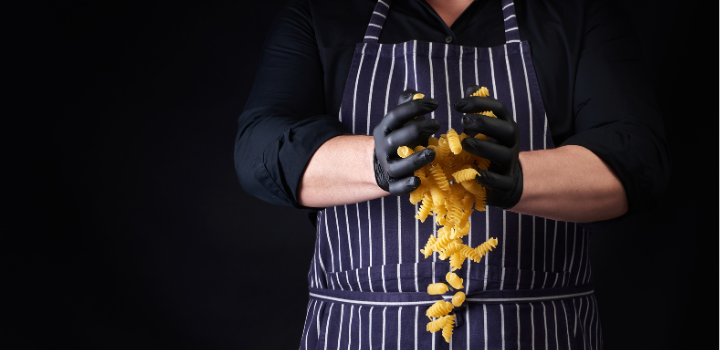Disposable gloves are an essential item in various professional environments, including the medical, food processing, and cleaning industries. They provide protection in terms of hygiene and are available in various colors, sizes, and materials.
Finding it difficult to determine which disposable gloves are most suitable for you? In this article, we will discuss the most common types of disposable gloves: latex, nitrile, vinyl, and vitrile. Additionally, we will differentiate between powdered and powder-free gloves.

Latex disposable gloves
Latex disposable gloves are made from natural rubber and have long been the standard in the medical and healthcare sectors. They offer excellent elasticity and fit, making them comfortable to wear. Latex gloves are resistant to tears and punctures, making them suitable for a wide range of applications. They protect against various bacteria but are not suitable for use with oil and grease. Some individuals may be allergic to latex, which is a disadvantage of this type of glove.
Latex gloves are suitable for:
- Working with food
- Healthcare tasks
- Contact with blood
- Cleaning work (without aggressive chemicals)
Nitrile disposable gloves
Nitrile disposable gloves are made of synthetic rubber and are a popular alternative to latex gloves, especially for individuals with latex allergies. They offer excellent resistance to chemicals, oils, and other harmful substances. Nitrile gloves are also much stronger than latex gloves.
Nitrile gloves are suitable for:
- Working with food
- Healthcare tasks
- Contact with blood, bodily fluids, and chemicals
- Cleaning work
- Handling medications
- People with latex allergies
Vinyl disposable gloves
Vinyl disposable gloves are made of polyvinyl chloride (PVC) and are resistant to oil and grease. They are less elastic and less comfortable than latex or nitrile gloves. These disposable gloves contain plasticizers, making them unsuitable for handling oily foods. Additionally, they are not resistant to solvents and ketones. They are suitable for light tasks where a high level of protection is not required.
Vinyl gloves are suitable for:
- Light hygiene tasks
- People with latex allergies
Vitrile disposable gloves
Vitrile disposable gloves are made from a combination of vinyl and nitrile. They combine the strengths of both materials and provide a good balance between flexibility and comfort. Vitrile gloves are resistant to oil, grease, and chemicals, making them suitable for a wide range of applications.
Vitrile gloves are suitable for:
- Working with food
- General healthcare tasks
- Cleaning work
- People with latex allergies

Powdered or powder-free gloves
In addition to the material from which the gloves are made, there is also a distinction between powdered and powder-free disposable gloves.
Powdered gloves have a layer of powder, usually cornstarch, on the inside of the glove. This powder makes it easier to put on and take off the glove. However, the use of powdered gloves is now less commonly recommended due to potential allergic reactions.
Powder-free gloves do not have any powder and reduce the risk of allergic reactions. In our range, all gloves are powder-free.
In summary, the choice of the right disposable gloves depends on your specific needs and the tasks for which you intend to use them.
